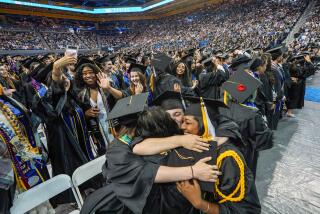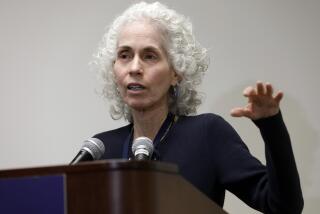Doctors, Others in Loan Defaults Listed : Crackdown: Names of 5,000 health professionals with overdue tuition aid appear in Federal Register. Move by the HHS marks a change in privacy rules.
In an unusual effort to pressure medical professionals into paying overdue student loans, federal officials released the names Monday of nearly 5,000 doctors, dentists and other health workers who have defaulted on more than $228 million in government loans.
The names also will be turned over to the Internal Revenue Service and the U.S. Justice Department for collection, said a spokeswoman for Health and Human Services Secretary Donna E. Shalala, whose department administers the loans to students entering health care fields. Borrowers whose repayments are overdue also will be barred from receiving reimbursement for Medicaid and Medicare patients they treat.
Shalala ordered the debtors’ names and the amounts they owe printed in Monday’s Federal Register, a widely read publication that contains information on new federal regulations and contract awards. The move represented a change in the government’s adherence to its own privacy rules, which until now have required that loan recipients’ names be kept confidential.
“We want to get the taxpayers’ dollars back,” said Patricia Campbell, a spokeswoman for the Health Resources and Services Administration, which oversees the federal Health Education Assistance Loan program. “Basically, we’re embarrassing them.”
Campbell said that those on the list--which includes the defaulters’ business addresses and the names of the medical schools they attended--were repeatedly asked to pay before their names were referred to collection agencies and credit rating bureaus. State court judgments also were obtained against them by banks and other private agencies that write the loans.
“We’re talking about real deadbeats here,” Campbell said.
Representatives of medical organizations offered no sympathy to those who have failed to repay their loans. But they worried about the possibility that some might have been misidentified, unfairly damaging their reputations and practices.
They also suggested that many debtors face extenuating circumstances. Some, for example, may work in rural or inner-city areas, where they perform valuable services but earn less than their counterparts in more affluent locales.
“These doctors do it in large part out of the old tradition of public service,” said Kirk Johnson, general counsel for the American Medical Assn.
Those named by Shalala included physicians, dentists, veterinarians, optometrists, chiropractors, pharmacists and graduate students in public health and psychology. Unpaid loan balances ranged from a few hundred dollars to more than $272,000. The average was about $45,000.
In California, more than 630 medical professionals were listed. According to Shalala’s department, the biggest single debtor in the state was a Vallejo dentist, Walter A. Baker, who the government said owes $252,384. Baker could not be reached for comment.
Listed as the state’s No. 2 debtor was Rancho Mirage dentist Harry M. Schneider Jr., who owes more than $226,000.
Schneider said that he originally borrowed $75,000 to put himself through Loma Linda University’s dental school. But during the five years he attended school in the late 1970s and early 1980s his debt nearly doubled because of interest rates that reached 19% and 20% annually, he said.
“It was like loan shark rates,” said Schneider, who put his income at $30,000 last year. “The interest you can never catch up with.”
Schneider said that the government sent him a repayment schedule demanding that he pay $2,500 per month--a figure far beyond his means. He said that he offered to sell his home and settle the debt for between $75,000 to $100,000, but the government refused.
Campbell conceded that such loans “are expensive” but noted that those who signed up for them were aware of the financial terms. Current interest rates are only 6%, she said.
Defaulters represent less than 4% of the 128,000 students in various health-related disciplines who have received $2.7 billion in loans since the program began in 1979. In October, Congress ordered defaulters’ names published annually after defaults jumped from $16 million in 1987 to $42 million in 1992.
Johnson, of the AMA, said that he is concerned about the government publicly pillorying so many medical professionals, saying it is likely that at least some were misidentified.
“Whenever there’s a mass-listing of physicians for one thing or another, some licensing problem or something, inevitably you’ll find there’s been some misidentification,” he said.
He also urged the government to forgive all or part of the balances owed by doctors and others serving low-income populations.
Campbell said that the loan program provides for reduced or suspended loan payments if a borrower is experiencing financial hardship.
More to Read
Sign up for Essential California
The most important California stories and recommendations in your inbox every morning.
You may occasionally receive promotional content from the Los Angeles Times.










